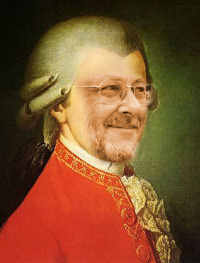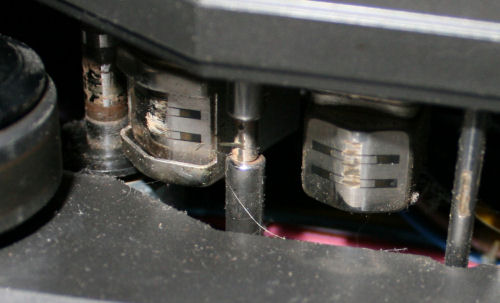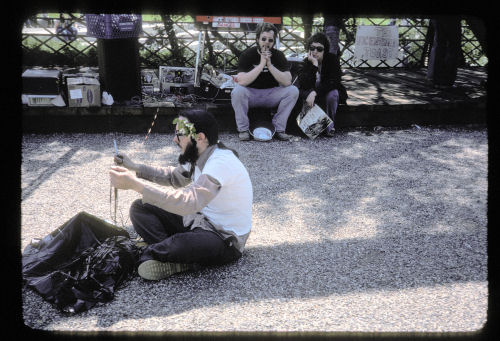A 365-Day Project
"We Are All Mozart"
A project to create
new works and change
the perception of the
music of our time.


 May 31, 2008
May 31, 2008 
Yesterday the idea of recovering an artifact, a recording of Mozart playing or conducting, was suggested. Impossible with today's technology -- we do not ever have viewers into the past, much less time travel. If such travel were possible, archiving would be moot. Everything would be live, all the time. If time is a coil that only imagination prevents us from stepping across, then we need keep nothing. The future will come into our past and retrieve what it wants. It will know what became important and why -- assuming, of course, those future navigators make no quantum disturbances that change their own future, or even step on something living ... how I shuddered upon reading A Sound of Thunder as a child.
So perhaps I am flapping my wings over something entirely unimportant in the grand scheme of human existence -- a few weak performances of weak pieces by weak players in a fading cultural niche in a meaningless geography within a once-powerful empire. But until then, these compositions may have significance -- and besides, I need to make copies of them. And in making copies, what did I learn?
This was a small sample of material, a mere eighteen pieces performed among perhaps five thousand on these shelves. Yet in this handful of recordings, there was tape deterioration, the gummy tapes exhibiting what is called "stiction" -- the tape binder liquifying and requiring baking to restore its cohesiveness. And these were mastering tapes holding some 200 hours of music. Then there are the fading formats. One of my two tape decks using dbx type I noise reduction has failed; the other is nearly twenty years old, and parts are no longer available. There are no cassette decks with Dolby C noise reduction left in the house -- both failed and are unrepairable -- but there are dozens of cassettes recorded using it. Even DAT (digital audio tape), once the future of recording technology in the early 1990s is at risk. There are nearly 1,000 DATs containing concerts, interviews, and musical examples as well as 538 of our radio shows, but only one deck of four survives. And yesterday I did not mention minidiscs, a short-lived format that used a proprietary Sony compression scheme. 160 minidiscs contain interviews with composers. And finally, there are the transfers that need to be re-done as digital technology improves and more can be unearthed under the analog tape hiss.
Surely that's enough tech talk, but it does raise the consciousness about the importance not only of technical formats and their lifespans but also of the medium itself. It was not long ago that the written word was the preservation medium of choice. For example -- and I cannot call to mind the location, but seem to recall it was a university in New York -- interviews were recorded with important people of the day (this was the early 1950s) and those interviews were transcribed and the tapes then erased and re-used. In an era when a long interview can be reduced to evanescent bits and those stored on a fraction of the surface of a spinning optical disk, it seems incredible that such destruction would have taken place -- even moreso that the sound of the voice and the inflection and emphasis were deemed insignificant, where today we search for sound and image to enable a richer understanding of meaning and person.
Secondary Effects
But you can't archive everything. So how much is enough? In restoring these recordings I realized that the Trans/Media site had been languishing. Trans/Media was a post-Fluxus cooperative of artists that lasted from 1973 to 1978 and created many events in and around Trenton, New Jersey. Trenton (curious motto: "Trenton Makes, the World Takes") was a rusting industrial hulk in the 1970s, situated about midway between New York and Philadelphia, themselves two dramatically different and often irreconcilable artistic cultures. In between was wasteland and decay. Trenton itself had now-wealthy suburbs that it had spurned merging with in the middle of the century, a rambling old depository library (where I worked as government documents librarian), a crime-ridden downtown, and its culture consisted of a shuttered grand art deco movie theater, an isolated State Museum on a barren plot of land by the Delaware River, and a broken down symphony orchestra (who, if their website is any evidence, has hardly advanced since then) that played at the Stalinesque War Memorial Auditorium.
Into this milieu came the young post-Fluxus artists -- many having been involved with the Vietnam anti-war movement -- to the western edge of town in a mixed heritage neighborhood. The rent was right and there were still trees. Also there was a drug store, a bakery, a bookstore, a tiny café, a butcher shop (I lived upstairs) and the kosher butcher shop next door, and even a small art gallery. The run-down Cadwallader Park (designed by Fredrick Olmstead, who also created Central Park in Manhattan) was a short walk. Surviving members of the Roebling family -- of Brooklyn Bridge fame -- lived around the corner. A middle-class black culture had risen out of their former status as servants to the wealthy families who had largely fled the area. On the corner was a Baptist church with a tiny congregation. Frank Stallone, my only private music student who lived across the street, was occasionally visited by his brother Sylvester.
Trans/Media grew out of a street festival -- all leather knick-knacks and street dancing -- where a dozen of us used an empty storefront to create a multimedia environment (note to younger readers: "multimedia" preceded personal computers) of sculptures, trees, a rose organ (see the fourth picture down), a dozen tracks of music from live electronics with Killer through the bogus "St. Hubert Mass" (marketed by the Musical Heritage Society from one of its wacko European purveyors and still found on an Erato cutout). The environment was marvelously cacophonous with speakers hidden overhead and in every corner, an inside maze of chromylar and cardboard, a glass breaking studio, and deep inside a delayed auditory feedback booth where the overridden sensory system left even rhetorical experts -- such as Trenton's erstwhile mayor Arthur Holland (who served 26 years in office and died in 1989) -- babbling uncontrollably. The delayed feedback was recorded on reels of tape which have not been played since they were recorded. (35 years, hmmm. Wonder how they sound? No, another day for that.)
That early Trans/Media Minifest was enough of a success that the informal collection of artists stayed together and began planning something larger. Having attended the New York Avant-Garde Festival at Grand Central Station in 1973, three of us (Richard Fredette, Linda Kay and I) thought we could expand the Trans/Media idea. The Grand Central event was Charlotte Moorman's tenth festival, and it was an inspiration. She herself represented the vastness of imagination, even if her artistic discipline was occasionally set aside; when David Gunn and I attended Jail to Jungle (a dramatization of the Opera Sextronique story) at Carnegie Hall in 1977, we couldn't bear to stay. It was lazy and uninspired. Nevertheless, Charlotte's diverse interests and selfless attention to other artists was my single greatest inspiration in the support of other composers, a task I have always taken to heart. And so we began the planning for an avant-garde festival in rustbucket Trenton.
This is not a history of Trans/Media. That will wait for another day, another year, because it was a headlong five years of creation -- three avant-garde festivals, seventy concerts, the co-creation of a statewide arts festival called "Kaxpiksu: The Solstice Revels," and the co-presentation of a contemporary arts series called "Alternatives" that brought together Phill Niblock, Joseph Celli, and our own Dashuki Music Theatre on one of its programs. And then one day after five years, having grown to a group of some fifty artists, we simply declared an end to it. We held a farewell meeting, and within a few months Trans/Media's artists dispersed across the continent. Some stayed in corners of New Jersey, but David Gunn, Claire Manfredonia and I went to Vermont; Fernanda D'Agostino to Montana and then Washington; Jane Branneky to Pennsylvania, California and eventually Florida; Trevor Bryant, Zoogz Rift and John Trubee to California; Suki Dewey to Amsterdam, Afghanistan, Colorado and India before returning to New Jersey; Richard Fredette and Jan Kounitz to New York; Maureen Gibbons to Florida; JoAnn Giordano to Ohio; Gail Sherman to Michigan and then Wisconsin; Mark Sherman to Washington. Some have died, others have simply vanished (where are you, Sam Senoff?). We may never have the greatness of Charlotte Moorman's generation, but we amply filled the difficult interstices between the avant-garde and postmodernism.
And so, transferring those old recordings reminded me that our news media history was slowly succumbing to acidic newsprint. I brought out the articles, scanned them, and put them on the Trans/Media website. There are still fliers, posters, handouts, and programs as well as thousands of slides and negatives, 8mm film, and prints all to be scanned, and the audio recordings of every event to be digitized. There will be time.
This rambling will continue over the next few days.
* * *

Gummy tapes end up depositing mountains of sticky emulsion on tape guides and heads, so much so that the tape can come to a dead stop. Here is just a few minutes of playing an untreated tape; the white material on the left head is mold that had also grown on the edges of the tape.

The opposite of preservation: Here I am destroying a tape composition as it plays for the last time, one among 40 on tape and on paper, during Detonacy 1976, part of the second Delaware Valley Festival of the Avant-Garde, produced by Trans/Media.